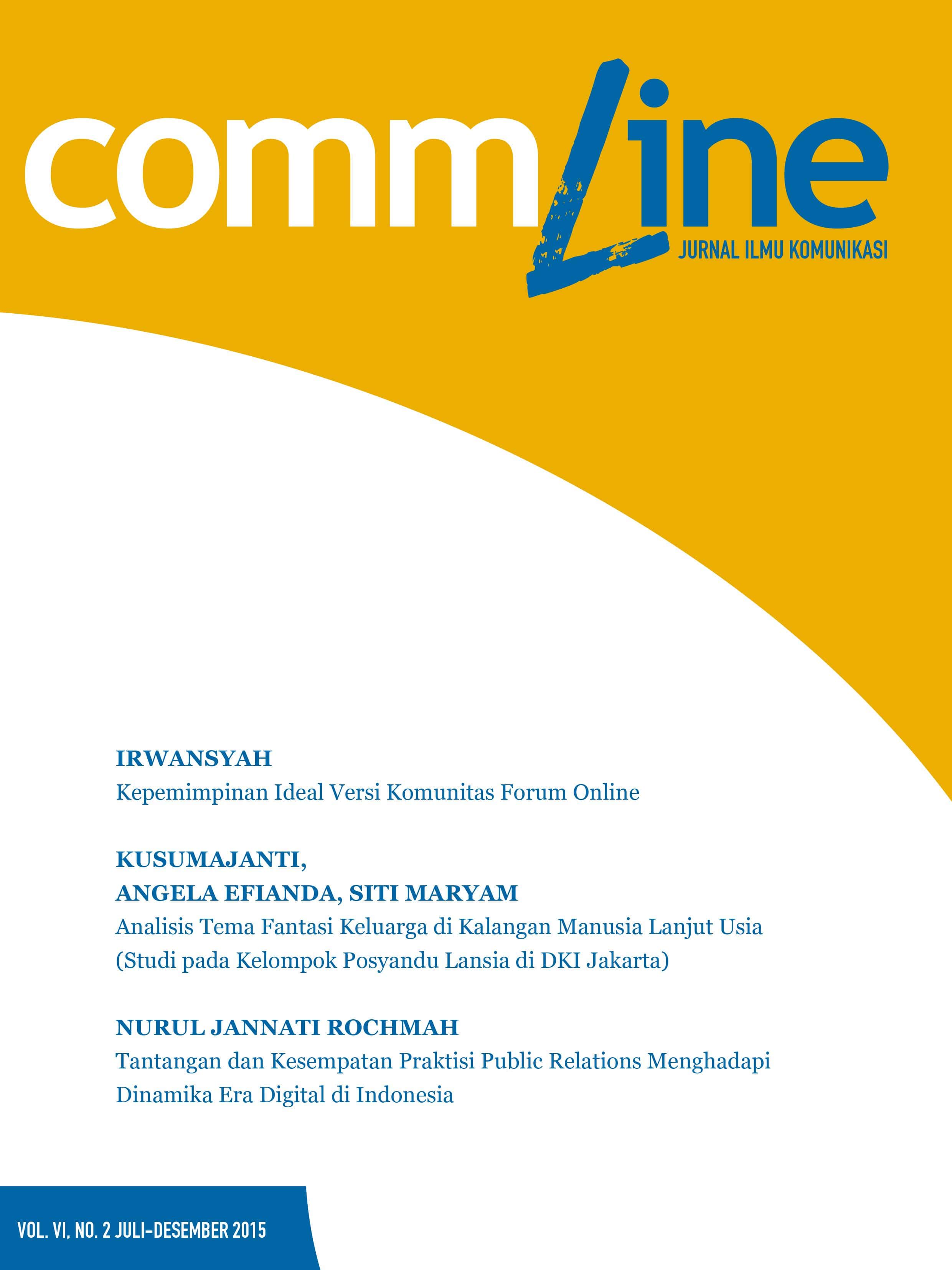Pendidikan Literasi Media untuk Menghadapi Risiko Online dan Jaringan Komunikasi Remaja di Internet
Keywords:
media literacy, online risks, communication network, adolescent, InternetAbstract
Internet usage can not be separated from the adolescents’ life nowadays. They use internet mainly for obtaining pleasure, although some of them are using it to help them in doing their school assignments. Internet is like a double edged sword for adolescents. In ternet has risks too for the adolescents, such as exposure to pornography, violent / racism content, misleading advertising, cyber bullying, and to certain extent we also heard that the contact with pedophile was done through internet (social media). Internet has made the outsider can reach adolescents from their personal subsystems. Internet is able to take them out of the boundaries of the community level and out of the social network which has been “kept†them. The question is, “are they aware the risk of using the internet?†To prevent things get worse in adolescents’ abuses, media literacy education is the answer and should be part of the Indonesian education system.
References
Abeele, M. V., Campbell, S. W., Eggermont, S.,
& Roe, K. (2014). Sexting, Mobile Porn Use, and Peer Group Dynamics: Boys’ and Girls’ Self-Perceived Popularity, Need for Popularity, and Perceived Peer Pressure. Media Psycholo gy , 17 (1), 6-33.
Andersen, N. (2006). A Media Literacy Education Perspective on Reflections of Me...The ETFO Body Image Project. Retrieved November 20, 2014, from The Elementary Teacher’s Federa- tion of Ontario: www.etfo.ca/resources/body- imageproject/pages/default.aspx
Bickham, D. S., & Slaby, R. G. (2012). Effects of a Media Literacy Program in the US on Children’s Critical Evaluation of Unhealthy Media Messag- es about Violence, Smoking, Food. Journal of Children and Media , 6 (2), 255-271.
Bosch, T. E. (2009). Using Online Social Network- ing for Teaching and Learning: Facebook Use at the University of Cape Town. Communicatio: South African Journal for Communication The ory and Research , 35 (2), 185-200.
Chen, Y.-C. (. (2013). The Effectiveness of Differ- ent Approaches to Media Literacy in Modifying Adolescents’ Responses to Alcohol. Journal of Health Communication , 18 (6), 723-739.
Cho, C.-H., & Cheon, H. J. (2005). Children’s Ex- posure to Negative Internet Content: Effects of Family Context. Journal of Broadcasting & Electronic Media , 49 (4), 488-509.
comScore. (2012, August1 16). ComScore Vid eo Metrix. Retrieved June 7, 2015, from www. comscore.com: www.comscore.com/insights/ online-video-measurement
Hargittai, E., & Walejko, G. (2008). The Participa- tion Divide: Content Creation and Sharing in the Digital Age. Information, Communication & Society , 11 (2), 239-256.
Juditha, C. (2011). Hubungan Penggunaan Situs Jejaring Sosial Facebook terhadap Perilaku Remaja di Kota Makasar. Jurnal Penelitian IPÂ TEK-KOM , 13 (1), 1-23.
Karman. (2012). Pola Penggunaan Media Digital di Kalangan Anak dan Remaja (Kasus di Kota Jay- apura Propinsi Papua). Jurnal Penelitian Pos dan Informatika , 2 (1), 35-50.
Kominfo. (2014, February 18). Siaran Pers Tentang Riset Kominfo dan UNICEF Mengenai Perilaku Anak dan Remaja Dalam Menggunakan Inter net. Retrieved April 20, 2014, from Kementrian Komunikasi dan Informatika Republik Indone- sia
Leung, L. (2014). Predicting Internet risks: a lon- gitudinal panel study of gratifications-sought, Internet addiction symptoms, and social media
use among children and adolescents. Health Psychology and Behavioral Medicine: An Open Access Journal , 2 (1), 424-439.
Leung, L., & Lee, P. S. (2011). The Influences of In- formation literacy, Internet Addiction and Par- enting Styles on Internet Risks. New Media & Society , 14 (1), 117-136.
Livingstone, S. (2009). Children and the Internet. Cambridge, UK: Polity Press.
Livingstone, S. (2011). Internet, Children, and Youth. In M. Consalvo, & C. Ess, The Handbook of Internet Studies (pp. 348-368). Sussex: Wi- ley-Blackwell.
Lull, J. (1985). The Naturalistic Study of Media Use and Youth Culture. In K. E. Rosengren, L. A. Wenner, & P. Palmgreen, Media Gratifications Research (pp. 209-224). California: Sage Pub- lications. Inc.
Monge, P. R., & Contractor, N. S. (2003). Theories of Communication Networks. Oxford: Oxford University Press.
Qomariyah, A. N. (2009). Perilaku Penggunaan Internet pada Kalangan Remaja di Perkotaan. Surabaya: Fakultas Ilmu Sosial dan Ilmu Politik, Universitas Airlangga.
Setiawan, A. B. (2011). Penanggulangan Dampak Negatif Akses Internet di Lingkungan Pondok Pesantren melalui Program Internet Sehat. Jur nal Penelitian Komunikasi , 14 (2), 99-114.
Staksrud, E., & Livingstone, S. (2009). Children and Online Risks. Information, Communication & Society , 12 (3), 364-387.
Tapscott, D. (2009). Grown Up Digital. How Net Generation is Changing Your World. New York: McGraw Hill.
Tempo.Co. (2014, Februari 18). Tifatul: 50 Persen Pelajar Pernah Akses Pornografi. Retrieved April 20, 2014, from www.tempo.co: http://www. tempo.co/read/news/2014/02/18/173555290/ Tifatul-50- Persen- Pelajar-Pernah-Ak- ses-Pornografi
UI, P., & APJII. (2015). Profil Pengguna Jasa In ternet Indonesia 2014. Jakarta: Asosiasi Penye- lenggara Jasa Internet Indonesia.
van Dijk, J. A. (2006). The Network Society. Social Aspects of New Media (2nd ed.). London: Sage Publications. Inc.
Wahyudi, M. Z. (2015, Mei 4). Perilaku Seksual Remaja. Ancaman HIV Begitu Dekat. Kompas . Jakarta, Indonesia: Kompas.
Walsh, K. R., Sekarasih, L., & Scharrer, E. (2013). Mean Girls and Tough Boys: Children’s Mean- ing Making and Media Literacy Lessons on Gen- der and Bullying in the United States. Journal of Children and Media, 8 (3), 223-239.

